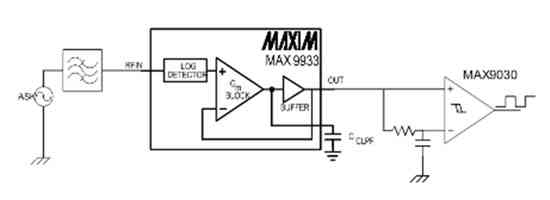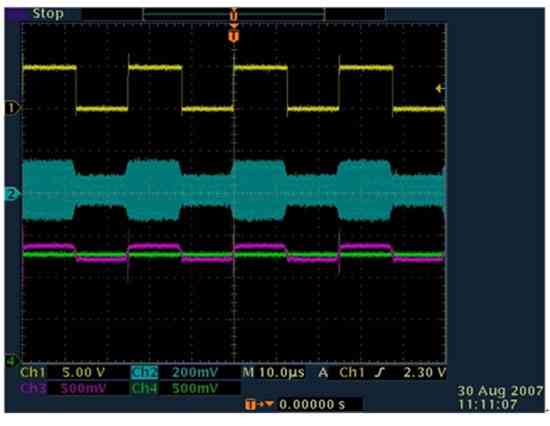Amplitude shift keying (ASK) is a digital communication modulation technique that is widely used in many low-frequency radio frequency applications. The simplest ASK method is when the signal source wants to send a '1', it sends a large-value carrier, and when it needs to send a '0', it sends a low-amplitude carrier. On-off keying (OOK) modulation is a further simplified version of this method. The signal source does not need to send a carrier when it needs to send a '0'.
ASK and OOK communication protocols are commonly used in short-range wireless communication applications, such as home automation, industrial networks, wireless base stations, remote keyless entry systems (RKE), and tire pressure monitoring systems (TPMS). OOK is particularly suitable for battery-powered portable devices, because such a system does not need to send a carrier when sending a '0', so it can save power. The carrier frequency involved in different applications may vary greatly. For example, it is about 2MHz in low-frequency wired communications in some base stations, and about 433MHz in short-range wireless communications using ISM bands (industrial, scientific, and medical).
Various wireless technologies, including Bluetooth, ZigBee, and Wi-Fi, have made some progress in the current consumer electronics industry. These protocols provide a mechanism for secure communication between devices. They usually work in the 2.4GHz ISM band and use a combination of frequency shift keying (FSK), phase shift keying (PSK), and amplitude shift keying (ASK) modulation techniques. . The security provided by these technologies includes channel frequency hopping and spread spectrum modes of communication. This scheme is difficult to be heard, so it has high security and can improve the anti-noise performance. All these methods consume transmission power when sending '0' and '1'. Unfortunately, these protocols still have relatively high complexity and high hardware implementation costs, especially when security and high noise immunity are not rigid requirements.
Wi-Fi is mainly used for high data rate and long-distance applications. For simple control + detection applications, it may be overkill. ZigBee is considered an ideal choice for emerging sensor networks, and Bluetooth is widely used in numerous consumer audio devices and personal wireless devices. Table 1 makes a simple comparison of different performance characteristics of Bluetooth, ZigBee and ASK / OOK methods.

Table 1: Comparison of Bluetooth, ZigBee and ASK / OOK features
However, the simple implementation of ASK / OOK hardware has become the preferred choice due to its low cost, especially in battery-powered applications with very long usage times, or where access point-to-point wired basic networks and wireless infrared links are possible. For different applications, the implementation cost of other technologies may be 2 to 5 times it. By implementing a two-way interrogation mechanism between the transmitter and receiver, sufficient security can still be achieved on this link, for example by exchanging special codes if necessary. Compared with OOK, ASK can provide better anti-noise performance, and the cost is lower than FSK, but the power consumption is higher than OOK.
1 The application of MAX9933 in the signal chain of ASK receiver
The ASK receiver front-end usually consists of three modules: an input band-pass filter used to distinguish the carrier frequency of interest from the broadband input noise spectrum, an envelope detector used to extract the information of interest, and a binary output used to generate the binary output Comparators. The trigger threshold level of the comparator comes from the output of the envelope detector itself; this allows the threshold level to be adjusted automatically with the received signal level.
One possible implementation of the front end is to use the RF power detector MAX9933, which can read input signals with a dynamic range of 45dB and a frequency of 2MHz to 1.6GHz. In particular, it can output a logarithmic voltage proportional to the signal level ranging from -58dBV to -13dBV (that is, 1.25mVrms to 223mVrms). Figure 1 shows the application of MAX9933 in the ASK receiver signal chain.

Figure 1: The application of MAX9933 in the ASK receiver signal chain
The RF signal fed into the FRIN pin is AC coupled externally. Because the MAX9933 is a peak-response RF detector, its basic function is a simple envelope detector, even for signals as low as millivolts. The logarithmic transfer function for the amplitude of the input RF voltage relative to the output DC voltage is proportional to dB, so the MAX9933 is very sensitive to very small signals, allowing the ASK receiver to easily distinguish between the input 1 and 0 signal levels. The value of the capacitor CCLPF determines the response bandwidth of the chip output, which in turn depends on the expected data rate. Figure 2 shows the output waveform when testing the power detector as an envelope detector, where the comparator uses an adaptive reference to generate digital output bits. The test waveform has a carrier frequency of 10 MHz and a data rate of 40 kbps. The CCLPF filter capacitor is 150pF, and the RC filter consists of a 100kΩ resistor and a 0.22μF capacitor.

Figure 2: The response of the MAX9933 RF detector to an RF input signal with a modulation frequency of 10MHz and a data rate of 40kbps.
Take a deep breath, close your eyes, the world has the freshest oxygen ...
Yu Quan's "Deep Breath" is well known to us, but as the environmental problems become more and more serious, the haze sky also increases, PM2.5 PM10 and so on Vocabulary has also been mentioned more and more, and air purifiers have quickly become popular on the market with this "air quality" trend. Along with this, the air-clean brand has sprung up, and various technologies are dazzling. Which ones are indeed effective and which are just tasteless propaganda? How does the Air Purifier bother us to get rid of pollution? And look at the editors for you.
Analysis of air purifier
The critical value of PM2.5 content is 75 μg / m3
The pollutants in the air mainly include soot, total suspended particulates, inhalable particulates (PM2.5) and fine particulates (PM10). The smaller the diameter of the particulates, the deeper the part that can enter the respiratory tract. 10 micron diameter particles It is deposited in the upper respiratory tract, and particles below 2 microns can penetrate 100% into the bronchiole and alveoli.
1k-5k air purifier prices vary greatly
The air purifier products on the market not only have various functions, but also have prices ranging from thousand yuan to tens of thousands. The pricing of imported products is generally higher than that of domestic brands. Except for the core technology of many brands, the promotion of purification effects is similar, and consumers need to choose according to demand.
The air quality standard of 74 key cities is only 4.1%
According to the data of the press conference held by the State Council Information Office on June 4, according to the new "Ambient Air Quality Standards", the six pollutants SO2, NO2, PM10, PM2.5, CO and O3 were evaluated, 74 new standards In the first phase of monitoring and implementation, the proportion of cities that met the ambient air quality standards was only 4.1%, and the other 256 cities implemented the old air quality standards, and the proportion of cities that met the standards was 69.5%.
Air purifier Air Cleaner Home air purifeir sales increased by 90.5% compared with last year
According to a report recently released by the China Electronics and Information Industry Development Institute, due to the haze weather, air purifiers have become the most concerned home appliance products, with sales of nearly 2.4 million units nationwide last year, a year-on-year increase of 90.5%; retail The amount reached 5.6 billion yuan, a year-on-year increase of 105.9%.
HEPA filter needs to be replaced in March
The filter of the air purifier is the same as the filter of the water purifier, and it is not effective for a long time. After long-term use, the accumulation of dust on the surface of the filter will also cause the filter to gradually fail. Therefore, when the haze is more serious, the non-washable HEPA filter needs to be replaced every three months.
Merchants claim that the purification rate is more than 99% for the concept of stealing
99% or even 99.99% seems to have become a slogan for many air purifiers on the market. Many brands of products promote their high removal rate of PM2.5 and formaldehyde. In fact, this kind of publicity is more of a kind. The slogan of stealing the concept, the removal rate of 99% is the effect of the material itself on PM2.5 and formaldehyde, not the effect of actually running in space.
Uv Air Purifier,Uv Air Purifier For Home,Uv Air Purifier For Office,Uv Air Purifier For Pollen
Ningbo Zhe Kai Electric Appliance Co.,Ltd , https://www.cnairpurifiers.com